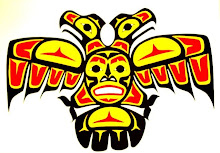Native artist and dancer Andy Everson is deeply involved with his culture, but his path wasn't an easy one because of a past law in Canada that stigmatized aboriginal women who married non-aboriginal men.
Everson, who is from the Comox Band, at one time wasn't even allowed to live on reserve after his mother married a Norwegian man.
By doing so, she and her children lost their Indian status. According to Canadian federal law at the time, if an aboriginal man married a non-aboriginal woman she gained Indian status, but if the opposite happened the woman lost her status. After the Indian Act was amended in 1985, Everson's mother was able to regain her status, as were her children.
"It defines who I am now," said Everson, who gives no hint of malice about the injustice. Though his family was "essentially kicked off" the reserve land, he still felt a part of the community.
Most of his childhood was spent in Courtney, but he would still attend potlatches growing up. Everson learned the values and ways of his people from his grandmother, who as a child lived in a traditional Big House and carried on her people's ancient traditions right up until her death at 99 years of age.
"When I was young our culture wasn't thriving as much as it is now but it was always around," said Everson, 37. "I started to get really involved as a teenager when I started to go to more potlatches and spend a lot of time with my grandmother. I'm really glad I did now. There were a lot of things to learn and she taught me my responsibilities and roles as a member of my community."
Everson, who is part of the famous Hunt family, was able to spend more time with his grandmother after his mother regained her Indian status and they were allowed to move onto the reserve.
He went on to university and got his master's degree in anthropology, which he saw as a "good fit" because of his aboriginal background. He wrote his thesis about contemporary K'omox Identity.
Since 1993 he has been a dancer with the LeLaLa Dancers, a traditional dance company from northern Vancouver Island. He is also an artist, producing two dimensional prints in a style that mixes Coast Salish and Kwakwaka'wakw, from Comox north.
The dance troupe has been performing regularly throughout the Winter 2010 Olympics at the Pan Pacific Hotel, which has been the site of many aboriginal cultural performances and demonstrations organized by the Aboriginal Tourism Association of B.C.
Everson's artwork is on display at the Aboriginal Artisan Village and Business Showcase, situated in the lobby of the Vancouver Community College, one block north of the Aboriginal Pavilion. The artist said he has been happy to see the aboriginal culture gain acceptance and understanding at the Games.
"For the most part, the involvement of aboriginal people was an eye opener to a lot of the world. That we exist and the indigenous people of Canada are quite diverse. You could see that at the opening ceremony. There was a wide variety of regalia and dance styles. The legacy is we're still here," he said.
kpemberton@vancouversun.com
© Copyright (c) The Vancouver Sun
Andy Everson's prints can be found at Tribal Spirit Gallery.
Saturday, February 27, 2010
Subscribe to:
Post Comments (Atom)

No comments:
Post a Comment